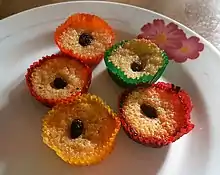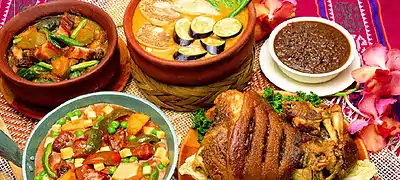 Almond and coconut macaroons | |
| Type | Biscuit |
|---|---|
| Course | Snack |
| Place of origin | France |
| Main ingredients | Almonds (or coconuts), egg whites |
| Other information | Cream filling, different flavours other than shown |
A macaroon (/ˌmækəˈruːn/ MAK-ə-ROON) is a small cake or cookie, originally made from ground almonds, egg whites, and sugar,[1] and now often with coconut or other nuts. They may also include jam or chocolate or other flavorings.
Etymology
The name "macaroon" is borrowed from French macaron, in turn from the Sicilian maccarone, a variant form of maccherone, the same word as macaroni. The origin of that is unclear; it may be from medieval Greek μακαρία 'barley broth' or μακαρώνεια 'funeral chant'. The etymology connecting it to Italian maccare 'to bruise'[2] is now rejected.[3] The word originally seems to have referred to a sort of gnocchi.
Origins
Macaroons can be traced to a French monastery of the 8th century in the city of Cormery.[4] Later, two Benedictine nuns, Sister Marguerite and Sister Marie-Elisabeth, came to Nancy seeking asylum during the French Revolution. The two women paid for their housing by baking and selling macaroons, and thus became known as the "Macaroon Sisters".[5]
Jews later adopted macaroons because it has no flour or leavening (macaroons are leavened by egg whites) and can be eaten during the eight-day observation of Passover.[5]
Recipes for macaroons appear in recipe books at least as early as 1725 (Robert Smith's Court Cookery, or the Complete English Cook), and use egg whites and almond paste. Mrs Beeton's Book of Household Management[6] includes a typical traditional recipe. Over time, coconut was added to the ground almonds and, in certain recipes, replaced them. Potato starch is also sometimes included in the recipe, to give the macaroons more body.
Preparation
Some recipes use sweetened condensed milk.[7][8] Macaroons are sometimes baked on edible rice paper placed on a baking tray.
Regional varieties
Dominican Republic
Macaroons in the Dominican Republic are very dark. Grated coconut is mixed with ginger and cinnamon.
France
There are many regional variations of French macaroon. The coconut macaroon is known as the "Congolais",[9][10] or "le rocher à la noix de coco".
Germany
Mandelhörnchen (Almond crescents) are a common treat in Germany. Made of a flour similar to that of the macaroon, they are formed to resemble a crescent, then covered in sliced almonds and dipped in chocolate.[11][12]
India
Thoothukudi in Tamil Nadu and Mangalore in Karnataka have their own varieties of macaroon made with cashews and egg whites, adapted from those introduced in colonial times.[13]
Ireland
A macaroon chocolate bar is made by Wilton Candy in County Kildare. The description on the packaging is "macaroon pieces in Irish milk chocolate." It was first made in 1937.[14] Cleeve's Irish Confectionery also make a macaroon chocolate bar, with ingredients including cocoa butter, milk powder and desiccated coconut.
Italy
Italy has a wide tradition of cookies and confections made from ground almonds, including pignoli. Ricciarelli are a soft almond variety originating from Siena. Amaretti di Saronno are a crunchy variety from Saronno.
Philippines

Philippine coconut macaroons are uniquely cake-like in texture. They are slightly crunchy on the outside and soft, moist and chewy on the inside. They are usually baked into small, colourful cupcake wrappers and topped with a raisin. They are popular during holidays and special occasions.[15][16][17]
Puerto Rico
In Puerto Rico, coconut macaroons are called besitos de coco (little coconut kisses). A few variations of besitos de coco can be found on the island, the most popular ones including lemon zest and vanilla as additional ingredients.
Spain
The carajito is a macaroon variant made with hazelnuts and honey from the town of Salas, Asturias in northern Spain.[18][19] A larger size version is commonly known as sultana or suspiros del moro.
Turkey
Acıbadem kurabiyesi is a traditional Turkish variety made of almonds, sugar and egg whites. The traditional recipes include a small amount of bitter almonds, which gives this macaroon its name. Because bitter almonds are not readily available, almond extract is typically used as a substitute. These are part of the stock-in trade of almost every bakery in Turkey, as they are seldom made at home.
United Kingdom
In the UK generally, the traditional almond macaroon often includes almond essence to strengthen the flavour, and is topped with an almond flake. Coconut macaroons are also popular.
Scotland
In Scotland, the Scottish macaroon has a dense, sugary centre and is covered in chocolate and roasted coconut. Traditionally they were made with cold leftovers of mashed potatoes and sugar loaf. When the macaroon bar became commercial the recipe no longer used mashed potato because of shelf life limitations. The modern macaroon is made from a combination (depending on producer) of sugar, glucose, water and egg white. These ingredients make a fondant centre. This recipe was reportedly discovered by accident in Coatbridge in 1931, when confectioner John Justice Lees was said to have botched the formula for making a chocolate fondant bar and threw coconut over it in disgust, producing the first macaroon bar.[20]
Macaroon chocolate bars are also popular in Scotland. Buchanan's make a macaroon with Belgian chocolate and toasted coconut. They are a long-established family business based in Greenock. Scottish macaroon is made with a paste of potato and sugar.
United States


Coconut macaroons are common in America. Commercially made coconut macaroons are generally dense, moist and sweet; they are available in a few flavors, and often dipped in chocolate. Homemade macaroons and varieties produced by smaller bakeries are commonly light and fluffy. Macaroons made with coconuts are often piped with a star-shaped tip, whereas macaroons made with nuts are more likely shaped individually due to the stiffness of the dough.
Mass-produced commercial macaroons in the United States are each about half an ounce, or 14 grams, in weight. They are not a highly processed product, containing only coconut, sweetener, starch, egg whites, and flavoring (if any). At about 60–70 calories each, however, they contain about 3–4 grams of saturated fat due to the coconut, and 3–4 grams of added sugar, depending on the particular flavor. They are vegetarian (not vegan as they contain egg whites), and contain no gluten, dairy, cholesterol, or sulfites.[21]
Due to containing no grains or leavening, macaroons are a staple snack among American Jews on Passover and come in a variety of flavors besides coconut, including chocolate, chocolate chip, vanilla and almond.[22]
See also
- Almond biscuit - similar to macaroons
- Cocadas - confectionery similar to small coconut macaroons
- List of almond dishes
References
- ↑ "macaroon (n.)". Online Etymology Dictionary. Douglas Harper. Retrieved 4 January 2010.
- ↑ "A Brief history of Macaroons". COR online. Judy Pister. 29 March 2013. Retrieved 3 February 2015.
- ↑ "macaroon, macaron, macaroni". Oxford English Dictionary. 2023.
- ↑ "Cormery Macarons, Loire Valley speciality - The Good Life France". thegoodlifefrance.com. 2021-07-26. Retrieved 2023-10-02.
- 1 2 Hochman, Karen (December 2008). "The History Of Macaroons". The Nibble. Lifestyle Direct, Inc. Retrieved 29 March 2009.
- ↑ Beeton, Isabella (17 December 2014). "XXXV: Recipes". The Book of Household Management. University of Adelaide. Archived from the original on 28 November 2009. Retrieved 4 January 2010.
- ↑ "Coconut Macaroons". Food Network.
- ↑ "Paradise Macaroons". Food Network.
- ↑ Meyers, Cindy (2009). "The Macaroon and Madame Blanchez". Gastronomica: The Journal of Critical Food Studies. University of California Press. 9 (2): 14–18. doi:10.1525/gfc.2009.9.2.14. JSTOR 10.1525/gfc.2009.9.2.14.
- ↑ "Recipe from le congolais ou rocher à la noix de coco". Chefsimon.com. Archived from the original on 29 June 2011. Retrieved 30 June 2013.
- ↑ "Mandelhörnchen: Süße Leckerei selber machen". BUNTE.de (in German). 2013-12-13. Retrieved 2021-02-13.
- ↑ "Mandelhörnchen selber backen - so geht's | LECKER". lecker.de. 6 March 2009. Retrieved 2021-02-13.
- ↑ Olympia Shilpa Gerald (8 December 2012). "In search of Thoothukudi macaroon". The Hindu. Retrieved 30 June 2013.
- ↑ "The Irish Macaroon Bar". irelandlogue.com. 24 September 2006. Archived from the original on 30 March 2016. Retrieved 29 March 2009.
- ↑ "Filipino Coconut Macaroons". Kawaling Pinoy. 5 September 2013. Retrieved 25 December 2016.
- ↑ "Filipino Style Coconut Macaroons". Ang Sarap. 2 June 2016. Retrieved 25 December 2016.
- ↑ Tina de Guzman. "Coconut Macaroons". Pinay in Texas. Retrieved 25 December 2016.
- ↑ "Carajitos del Profesor". Archived from the original on 26 May 2018. Retrieved 19 March 2014.
- ↑ Llano, Loly. "Carajitos del Profesor". O Garfelo. Retrieved 19 March 2014.
- ↑ Reid, Scott (18 September 2006). "Lees' Miquel targets new markets". The Scotsman. Edinburgh: Johnston Publishing Ltd.
- ↑ Nutrition information on packages
- ↑ Lin-Sommer, Sam (15 April 2022). "How Coconut Macaroons Earned a Place on the Passover Table". Atlas Obscura.
